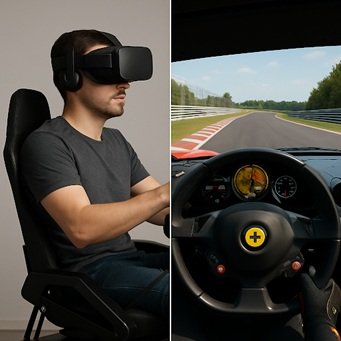Virtual Reality (VR) offers immersive experiences that transport users to entirely new environments, but when paired with motion platforms, the realism can either elevate the experience or completely break it. That’s where synchronization comes in. Whether it’s a racing simulator or a VR roller coaster, syncing visual inputs with physical motion is essential for user comfort and believability. A leading vr roller coaster simulator supplier will always prioritize precise timing to ensure users feel every twist and drop in real-time.
The Brain’s Need for Harmony
Our brains are constantly interpreting signals from various sensory systems: sight, sound, touch, and inner balance (vestibular system). In real-world movement, these senses align naturally. But in a VR simulation, if what you see doesn’t match what you feel, it leads to disorientation.
This sensory mismatch—where your eyes see rapid motion but your inner ear doesn’t register the same physical acceleration—can result in motion sickness. Known in the VR world as “simulator sickness,” this is one of the main reasons users cut their experience short. Even a 100-millisecond delay between visual movement and physical platform response can disrupt the illusion.
Why Split-Second Timing Matters
Synchronization is not just about preventing nausea. It also affects:
1. Realism
A lagging or out-of-sync motion platform breaks immersion. If a racing game shows a sharp left turn, but the seat reacts a fraction of a second later, it creates an artificial feel. When timed correctly, though, the user genuinely feels like they’re in the vehicle, responding to terrain changes, collisions, and acceleration.
2. Safety
In commercial setups such as VR arcades or training simulators, poor synchronization can lead to dangerous jolts or unexpected movements. This can result in injuries or lawsuits. High-end systems incorporate motion cueing algorithms to ensure smooth, real-time response even during complex sequences.
3. Training Effectiveness
VR motion platforms are now widely used in aviation, military, and emergency response training. These simulations require exact alignment between visual cues and physical sensations to teach muscle memory and spatial awareness. In high-stakes scenarios, milliseconds matter—poor synchronization could reinforce incorrect reactions.
What Affects Synchronization?
Several components must work together seamlessly to achieve proper sync:
1. Software Integration
Motion cues must be translated from the VR application to the motion base. Any mismatch between the game engine and motion software will create lag. That’s why platforms typically include SDKs or APIs that communicate with Unity, Unreal Engine, or proprietary systems.
2. Network Latency
In multiplayer VR setups or cloud-based systems, latency can occur due to slow data transmission. If the motion base relies on real-time data from a remote server, even slight delays can break synchronization.
3. Hardware Response Time
The mechanical structure of the motion platform itself matters. Actuators, motors, and sensors must respond quickly to inputs. Some systems operate with delays due to power constraints or poor engineering, making them unsuitable for high-speed simulations.
Calibration and Testing
Leading manufacturers build calibration tools into their systems to ensure real-time feedback. This includes:
- Pre-session diagnostics: to align motion profiles with visual timelines.
- Dynamic response testing: to measure lag under various loads.
- User-specific settings: to adjust sensitivity based on age, weight, or susceptibility to motion sickness.
How Synchronization Enhances Entertainment Value
The entertainment industry, particularly VR arcades and theme parks, benefits hugely from well-synced motion platforms. A roller coaster simulator, for example, is only convincing when each drop, twist, and turn matches perfectly with the headset’s visuals. This level of synchronization increases repeat visitors and generates positive word-of-mouth, directly impacting business success.
Moreover, consumers today have higher expectations. As VR technology becomes more accessible and affordable, poorly synchronized experiences are quickly dismissed as amateurish. Investing in motion platforms with high sync precision becomes not just a technical need but a branding decision.
Final Thoughts
Synchronization in VR motion platforms isn’t a minor detail—it’s the backbone of immersive, believable, and safe virtual experiences. Whether you’re designing a high-end racing simulator or a training program for pilots, synchronization is what turns a virtual scene into a convincing, visceral event. Without it, even the most visually stunning experience falls flat.
As the industry grows, expect even tighter integration between software, hardware, and AI-driven motion cueing. The future of VR will depend not just on what we see, but how accurately we feel it.
